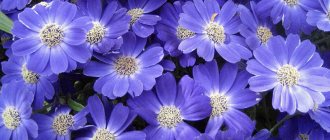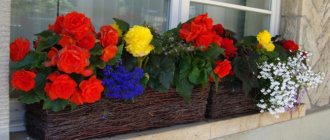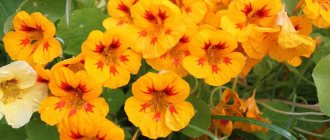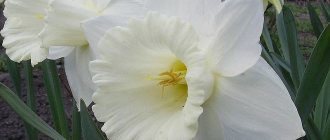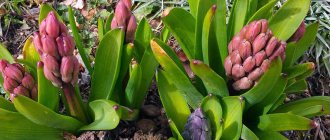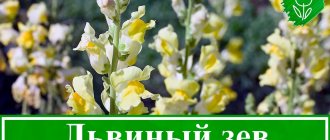Author: Tamara Altova. 01 September 2018
Category: Garden plants.
Sage, or Salvia (lat. Salvia) is a genus of herbaceous perennials and shrubs of the Lamiaceae family, common in the nature of the New and Old Worlds. The name of the genus comes from the word salvus, which means “to be healthy.” According to The Plant List from 2013, there are 986 species in the genus. The salvia flower has been known since ancient times for its medicinal properties, but some species not only bring benefits, but can also provide aesthetic pleasure, since they are highly decorative. Those species of the genus that are grown for medicinal purposes are usually called sage among gardeners, and plants that are primarily valuable for their decorative qualities are called salvia.
Salvia (sage) flowers - description
The tetrahedral, erect or ascending, simple or branched stems of salvia can reach a height of 120 cm. The opposite leaves, located on long petioles, can be entire or pinnately dissected. Sage leaves are dark green on the upper side and lighter green below. Salvia flowers with a two-lipped corolla, the color of which varies from white to purple, form complex whorls of spike-shaped or paniculate inflorescences. The upper lip of the flowers is straight or crescent-shaped or helmet-shaped, the lower lip consists of three lobes, the middle of which is usually much larger than the lateral ones. The salvia fruit is formed from four nuts filled with seeds.
Sage and salvia - what's the difference?
Salvia also has another name - sage. The same medicinal sage, the tincture of which we are used to gargling with, and the beautifully flowering bush are two types of the same plant. In Europe, all types of salvia (Latin salvus - “to be healthy”) are called sage; in our country, a division is accepted: ornamental bushes used in landscape design are called salvia. A spicy medicinal plant used in medicine is called sage.
But ornamental plants can also be different: some varieties live only for a season, others are planted before winter and enjoy the lush colors in the summer, while others in warm climates are able to grow and please the eye for several years. By nature, all salvia flowers are perennials, but they are not able to withstand severe frosts and often freeze in winters with little snow, so most often the flower is grown as an annual or biennial. All types of salvia flowers can be divided into three groups:
American - heat-loving plant varieties are usually annuals and grow only in warm climates.
Mediterranean - varieties of medium winter hardiness. The bushes of the plant can survive not very harsh winters, but during snowless and light snowy winters they often die.
Winter-hardy varieties - they are grown in temperate climates. A large group includes biennial varieties that are unpretentious in choosing a planting site and require little shelter for the winter.
There are a lot of varieties of salvia - more than 900. For decorative purposes, two types are most often used for landscape design:
- shiny;
- sparkling.
The plant reaches a height of 25-80 centimeters and has different color options. For two-year cultivation, salvia flowers are planted as seedlings in the fall, and they are covered for the winter.
Annuals have a short lifespan, so salvia is often grown as seedlings, taking care of its planting in early spring. So, with the end of spring frosts, seedlings can be planted in flower beds and garden beds.
Growing salvia from seeds
Sowing salvia for seedlings
In our conditions, annual salvia is grown by seed, both seedlings and non-seedlings. In regions with a warm and mild climate, the seeds are sown in the ground in the spring or before winter, and in areas with cold winters and late spring, salvia is grown through seedlings, although in the southern regions the seedless method allows you to see the flowering of sage much earlier than when sowing seeds directly in priming. When to plant salvia seeds for seedlings? The best time is the end of February or the beginning of March.
Sow salvia seeds in a box with light seedling substrate, which can be purchased at a garden pavilion or in a specialty store. First, a layer of expanded clay is placed on the bottom of the box, washed with a strong solution of potassium permanganate, then the container is filled with soil, two weeks before, a spilled fungicide solution or a bright pink solution of potassium permanganate. There should be at least 2 cm from the surface of the substrate to the edge of the box walls. The soil is well moistened, after which the box is covered with glass or film and allowed to stand until the morning. Salvia seeds mixed with coarse sand are evenly distributed over the surface of the substrate, lightly pressed against it, sprayed with a spray bottle, covered with glass or film and kept at a temperature of 20-25 ºC until germination.
Caring for salvia seedlings
The seeds will begin to germinate on the 7-10th day, and as soon as the first shoots appear, the crops are moved to the lightest windowsill. For normal development, salvia flower seedlings require a 12-hour daylight hours, and if there is insufficient lighting, install an artificial light source above the box at a height of 20-25 cm - a gel lamp, LED or phytolamp.
Growing salvia during the seedling period requires regular watering and two pickings. When watering the substrate, moderation should be observed, since waterlogging can cause rotting of the base of the seedling stem, or black leg. If you find this problem, immediately remove the glass, stop watering for a while and, after removing the already laid seedlings, sprinkle the surface of the substrate with sand or sifted ash. If the soil becomes soggy, it is better to transplant the seedlings into a new substrate.
The first time salvia is picked is at the stage of development of two true leaves. The seedlings are transplanted into separate cups filled with the same seedling substrate in which the sowing was carried out. After picking, the seedlings are shaded from the sun for 2-3 days. When they develop three pairs of leaves, the tops of the seedlings are pinched for better tillering. In order for the seedlings to grow strong, they are planted a second time in pots with a diameter of 9 cm. Two weeks before transplanting to the flowerbed, the seedlings are subjected to hardening procedures: they are taken out into the open air every day, providing protection from drafts and gradually increasing the duration of the sessions. By the end of the two-week period, salvia from seeds should fully adapt to the environment in which it will soon find itself.
Step-by-step guide to planting salvia seedlings
In order to grow a beautiful and healthy plant, you need to know the sequence of actions that need to be taken when planting, as well as several tricks and subtleties.
Seed selection and preparation
You need to buy seeds only from a trusted manufacturer, also pay attention to the packaging. There should not be any violations on it; they may indicate a violation of the rules of transportation and storage. If these rules were violated, then the seeds could spoil, and a healthy and beautiful plant would not grow from poor planting material.
Seeds must be treated with a disinfectant solution before planting. You can place the seeds in a solution of potassium permanganate for 15 minutes and then dry.
Some seeds are already ready for planting without prior preparation, for example those that are sold in a special shell, they are called pelleted.
Soil preparation
For salvia, store-bought soil for flower crops is suitable, but you need to make sure that it is loose and light.
If you prefer to make your own soil, then you need to mix forest soil, peat and washed river sand in equal quantities. How to choose and prepare soil for seedlings
Mix all components and carry out the disinfection procedure.
Selecting a landing container
There are no strict requirements for capacity; you can use any plastic or wooden containers or boxes. Cardboard boxes after milk or cut-off bottles are also suitable.
If your container does not have drainage holes, you will need to make them yourself. To do this, simply make small holes in the bottom of the container.
Salvia seed sowing scheme
Salvia is sown as seedlings in the same way as any other flower crop, and even an inexperienced gardener can cope with this procedure.
Detailed sowing scheme:
- First, place a drainage layer on the bottom of the container, but do not forget that drainage holes are also needed;
- Fill the container with pre-prepared soil, but not to the very edges;
- Water the soil thoroughly;
- Scatter the seeds over the surface of the ground;
- It is not recommended to sprinkle the seeds with soil; you can pound them into the ground a little with your finger;
- Water the seeds using a sprayer;
- Cover the container with a lid or film to create a greenhouse effect.
Planting salvia in open ground
When to plant salvia in the ground
Salvia seedlings are planted in open ground in early June, when warm summer weather sets in. Almost all types of salvia have the advantage of being drought-resistant and grow well in full sun. The only exception is salvia adhesive, which prefers partial shade and rich, moist, nutritious soil, while all other species grow better on dry, lime-rich, not too light, but at the same time permeable soils.
How to plant salvia
Before planting salvia, the area is dug up and leveled. Holes with a volume of one and a half times larger than the root system of seedlings with an earthen ball are placed at a distance of 25-30 cm from each other. Seedlings are transferred from pots to holes, placed in the center, and then the remaining space of the hole is filled with soil. After planting, the surface of the area is compacted and each seedling is watered abundantly at the root. Planting is carried out on a cloudy day, but if the weather is clear, then it is better to plant the seedlings in the flower garden after sunset.
Landing algorithm
Perennial red salvia (photos of flowers in flower beds will allow gardeners to make a choice in favor of decorative sage) is grown from seeds, by cuttings, dividing the bush or by air layering. But, as a rule, the seed method is the most common and effective.
You can sow salvia at the end of autumn, and keep the seedlings in the house until summer. Or you can sow in early spring, then by the beginning of June the sprouts will be well strengthened and ready for planting in open ground.
Algorithm for planting salvia seeds:
- Since the seed of these flowering plants is quite fine, it is recommended to mix it with coarse sand. Then the sowing will not be too dense, which will allow you to get the maximum yield of new plants.
- Containers prepared in advance for sowing seeds are first filled with a drainage layer of 1/3, and then with soil mixture.
- Before sowing, the soil is moistened with a spray bottle. Small salvia grains are sown on moist soil. There is no need to deepen, cover the top with soil or additionally water the seeds. They are so tiny that they will not be able to get through the thickness of the soil.
- The containers are covered with glass, transparent film or plastic, which is necessary to create greenhouse conditions. Then they go to the windowsill, where there is no direct sunlight or drafts. The most favorable conditions for seed germination are an air temperature of at least 24° C, diffused light, and room humidity of about 50%.
- The greenhouse is removed daily for ventilation, and the collected concentrate is wiped off. You need to ventilate containers starting from 15-20 minutes, increasing the time by 5-10 minutes every day.
- After the first two true leaves appear, the greenhouse is completely cleaned.
- Daylight hours for seed germination should be 12 hours, so the plant requires additional lighting.
- The soil should be moistened by spraying from a spray bottle, which will avoid damaging young, fragile shoots.
- After the appearance of the real 4 leaves, the seedlings are planted in separate containers (diameter approximately 10-12 cm), where the seedlings will remain until transplanted to a permanent place.
- 2-3 weeks after picking, the seedlings are fed with complex mineral fertilizers or organic matter. It is advisable to add organic matter and mineral mixtures alternately, which applies not only to young shoots, but also to adult bushes.
- 14 days before planting the sprouts on the site, they need to begin to be hardened. Containers with seedlings are taken outside first for 1 hour, then increasing the time the plant stays outside until the whole day. This way the plant hardens and gets used to lower temperatures, which will allow it to take root faster in a new place.
Since salvia seeds are quite small, it is not possible to sow them at the correct distance. Therefore, many advise picking twice. The first time in order to discharge the crops, and the second time to plant seedlings in separate containers.
As soon as the weather returns, the temperature stabilizes at no lower than 25° C, and the ground warms up to at least 15° C, seedlings can be planted in open ground. Young bushes are planted in holes, at the bottom of which a drainage layer is laid, then a handful of ash and mineral fertilizer. The distance between the holes should be 20 cm.
Salvia can be propagated by cuttings, dividing the bush or air layering throughout the entire season, regardless of the flowering of the bushes.
Caring for salvia in the garden
How to care for salvia
Planting salvia and caring for this crop in the open ground is work that even a novice gardener can handle. You will need to occasionally water the sage, apply fertilizer, loosen the soil in the area, remove weeds and wilted flowers. With insufficient or improper care, it may be necessary to protect the plant from diseases or pests.
Watering and feeding salvia
Salvia does not require regular watering, and in a season with normal amounts and frequency of precipitation, it requires almost no additional soil moisture, since one of the main characteristics of this crop is drought resistance. But sometimes in the summer there is abnormally hot and dry weather, and if this period drags on, the salvia will need to be watered with water heated in the sun in the evenings. The day after watering or rain, you need to carefully loosen the soil in the area and remove weeds.
As for fertilizing, they are applied twice: during the seedling period between the first and second picking and after planting in the ground, when the plant begins to form buds. Mineral complexes are used as fertilizers, and the concentration of the solution in the first fertilizing should be two times weaker than suggested in the instructions.
Salvia after flowering
Salvia blooms in June and fades with the first frost, although each species has its own flowering time. When the plant loses its decorative appearance, dispose of the bushes and dig up the soil in the area to the depth of a spade bayonet. Rare in our latitudes, perennial salvias are cut almost to the ground, and mulched on top for the winter with a layer of garden compost, under which the plant roots can easily overwinter. Young plants are additionally covered with dry leaves or spruce branches.
Care after picking
- In the first week after picking, the plant should not be exposed to direct sunlight.
- Make sure the temperature is 22-24 degrees.
- The watering scheme does not change; it must also be carried out on a regular basis using a small watering can.
- It is recommended to pinch the top; the plant can be pinched when three pairs of true leaves appear.
- If necessary, you can add more soil, the main thing is that it is immersed in the soil up to the cotyledon leaves.
Hardening off seedlings by taking them out into the fresh air should begin in April
Pests and diseases of salvia
Salvia is extremely resistant to fungal diseases, but it is useless to fight viral or bacterial diseases; you just need to remove the affected plants from the area and prevent the development of these infections using agrotechnical and preventive methods. As for pests, salvia can suffer from aphids, whiteflies and spider mites, especially if the flower garden is located close to vegetable beds. Plants are treated with insecticidal preparations against aphids and whiteflies, and acaricides are used to get rid of spider mites.
Salvia leaves can be damaged by slugs and snails. To protect plants from mollusks, pieces of bark or slate are laid out around the area, which will make it difficult for pests to move, and a small ditch is made around the flowerbed and filled with large crushed stone. You can also catch slugs with bait: dig a glass jar into the ground, literally flush with the surface, and fill it a third with beer or a fermented sweet drink - juice, compote, honey water. Once trapped in a jar, slugs will no longer be able to get out of it.
How to care for salvia seedlings
Until the sprouts appear from the soil (granulated seeds take longer to germinate, so they are planted earlier), the soil needs to be moistened - from a spray bottle, but better - through a tray, pouring water into it. Excess water must be removed from the pan so that the roots of the seedlings do not rot.
If you feel that more water has been absorbed into the soil than necessary, you can remove excess moisture by removing the film from the box and sprinkling fine sand or ash on top of the soil.
Important points when growing salvia seedlings:
The main point of obtaining strong, healthy seedlings is the correct organization of lighting and maintaining optimal ambient temperature. It should be +25 degrees Celsius during the daytime, and at least +20 degrees at night.
In early spring, even on a sunny day, natural light will not be enough, so place boxes with salvia seedlings in the daytime in the brightest and warmest place, if necessary, providing heating and lighting using fluorescent lamps.
Gradually, salvia seedlings need to be hardened off: to do this, briefly remove the film from the boxes every day. Start with 10 minutes a day, gradually increasing this time. You can remove the film when the seedlings become strong.
Types and varieties of salvia
Salvia species are divided into four groups, and we will introduce you to representatives of each of them.
The first group includes salvias that grow in humid subtropical and tropical regions of America. In their natural habitats, these species live for several years, but in our climate they are grown as annuals. They are demanding on temperature and soil moisture and are damaged even by minor frosts. The first group includes such popular salvias as the bright red, powdery and most commonly grown salvia, shiny or sparkling. Salvia divinorum, or Salvia divinorum, also belongs to the first group.
Salvia vermilion is native to South America. This is a subshrub or herbaceous plant from 50 to 70 cm high with straight, densely pubescent branching stems, finely serrated along the edges, petiolate ovoid leaves with a heart-shaped or truncated base and a pointed apex and loose inflorescences up to 20 cm long of 4-8 flowers with a scarlet-red corolla. The long and flexible stems of this species are prone to lodging and require staking, but bright red salvia can also be planted in hanging structures. The best varieties of the species, which are grown specifically as hanging ones, are:
- Lady in Red - a bush 35-40 cm high with bright red flowers;
- Cherry Blossom is an early blooming salvia with pink flowers up to 40 cm high.
Mealy salvia is found in the wild in New Mexico. This is a non-capricious plant characterized by long flowering. The short-haired stems of salvia reach a height of 60 to 90 cm. Petiolate, oblong leaves wavy at the edges can be bare or slightly pubescent along the veins. Whorls consisting of 5-28 dark blue and sometimes white flowers are formed on tall peduncles. The axis of the inflorescence and the calyx are covered with dense pubescence, dark blue or light gray, respectively. The most famous varieties of mealy salvia:
- Victoria is the most famous variety, blooming luxuriantly with dark blue flowers;
- Anschuld - a bush with silvery white flowers;
- Strata is a compact bush with blue inflorescences.
Salvia splendor, or salvia sparkle, is most commonly found in nature in Brazil. This is a perennial plant, which in our climate is grown as an annual crop and forms densely leafy bushes of an obovate shape. Salvia sparkle has opposite, entire, ovate leaves that are dark green above and light green below. Large, irregularly shaped bright red, white, purple or pink flowers are collected in 2-6 pieces in a brush up to 25 cm long.
Plants of this species have become widespread in cultivation since 1822, and today Salvia sparkling is represented by a large number of varieties. Among the cultivars with red flower colors, the most popular are Vesuvius, Fire Flame, Flash, Fire Star, Scarlet Pidgey, Sahara, Fireball and Salvator. Among the varieties with pink flowers, Sizzler Orkid is most often grown, but the two-color hybrids Vista Sharlach Bicolor and Salsa Bicolor are in highest demand. On sale there are mixtures of Parade and Phoenix varieties with flowers of different colors.
The second group of salvias is represented by plants from the Mediterranean. They are perennials that are grown as annuals in cool climates. Compared to representatives of the first group, Mediterranean species are less whimsical, and they can be dug up for the winter and kept in a bright, cool place, and again planted in the garden in the spring. This group includes salvia green (variegated), whorled, dandelion-leaved and Yurisich. However, only one species is popular in gardening.
Salvia variegated, or green, is found in nature in the territory from Southern Europe to Western Asia. The Horminum variety of Salvia variegated with brightly colored bracts has a high decorative value. This plant reaches a height of 40 to 60 cm. It has numerous straight, branching stems, covered with simple and glandular hairs, petiolate oblong leaves, crenate along the edge and also pubescent, and simple inflorescences up to 30 cm long, consisting of pinkish or pale purple flowers with correspondingly bright pink or blue-violet bracts. The best varieties of the species:
- White Swan - bushes up to 60 cm high with creamy white bracts, but on some plants the upper leaves are purple or pink;
- Pink Sandy - salvia up to 60 cm high with pink bracts;
- Oxford Blue is a bush up to 70 cm high with violet-blue bracts.
Sometimes all these varieties are sold in a mix called Bouquet.
The third group includes salvia species that winter in open ground. As a rule, these are herbaceous plants from temperate zones of the Old World. These include salvia oak (forest), sticky, meadow, lush and Ethiopian. For ornamental gardening, only lush salvia, which has a hybrid origin, and forest salvia are of interest.
Salvia lush is a natural hybrid of Salvia sylvestris, a perennial plant reaching a height of 60 cm and blooming profusely with spike-shaped inflorescences of blue-violet flowers. The best varieties:
- Snow Hill - bush with white flowers;
- East Friesland is a compact plant with dark purple inflorescences;
- Blue Hill - a variety with lilac-blue flowers;
- Blue Queen is a drought-tolerant salvia with blue-violet flowers;
- Rose Queen is a plant with pink flowers.
Salvia oak, or forest, grows in dry meadows and steppes of Western Asia and Central Europe. Its stems are branched, straight, pubescent, from 30 to 60 cm high. The lower petiolate leaves with a sharp apex, a rounded or heart-shaped base and a crenate edge have a slightly wrinkled texture. The upper leaves are sessile and small. Inflorescences up to 40 cm long are formed from whorls, each of which consists of 2-6 flowers with a violet-blue corolla. Salvia forest is represented by the following varieties:
- Mainakht is an early variety with dark violet-blue flowers;
- Plumosa is a plant with dark lavender flowers on peduncles up to 40 cm high;
- Marcus is a low-growing variety (25 cm) with dark blue flowers;
- Adrienne - salvia with white flowers;
- Caradonna is a variety with almost black stems and dark purple flowers.
The fourth group is formed by rare and less cultivated species of salvia: swamp, lavender, azure, nutmeg, rejected, drooping, silver and scabiose. So far, these plants are found only in collectors' gardens.
Description and features of salvia
The salvia flower has been known for a long time; it belongs to the herbaceous shrubs of the Lamiaceae family. Translated from Latin, its name means “medicinal”. In ancient times, some varieties of salvia were planted for medicinal purposes.
More than 900 species of this shrub are known in nature, but not all of them are ornamental plants. Medicinal and spicy varieties are usually called sage, and all others are called salvia.
Ornamental salvia is a perennial shrub with a powerful rhizome, which in Russian latitudes is usually planted as an annual, or more often biennial, plant. It tolerates mild winters well, but dies in harsh climates.
The stems of the shrub grow up to 1.2 m. They are erect, with solid dark green leaves, which are located opposite on the trunk. The leaf blade is darker colored on the outside and has a whitish coating on the inside.
Salvia blooms with small flowers collected in spike-shaped inflorescences. The length of one inflorescence reaches 15-20 cm. The color of the petals can be pink, white, purple or lilac. The bush blooms for a long time.
After flowering, the bush forms a fruit in which the seeds ripen. They are ready for harvest a month after flowering and retain their viability for more than 4 years.
Properties of medicinal sage - harm and benefit
Medicinal properties of sage
The most famous species of the Salvia genus is medicinal sage (lat. Salvia officinalis) , which is known to almost everyone who suffered from toothache and gumboils. This plant with oblong leaves and purple inflorescences reaches a height of 50 cm. The species has been in cultivation since 1597. The following varieties and garden forms of Salvia officinalis have been bred for decorative floriculture:
- Purpurascens is a plant with purple-violet leaves;
- Crim de la Crime is a variety with variegated leaves;
- Tricolor is a plant with beige-yellow leaves with purple splashes.
As a medicinal plant, sage is widely used in folk medicine. Hippocrates also pointed out its healing properties, who recommended taking the plant to prolong youth and restore strength. Sage inflorescences and leaves contain essential oil, which includes linalool, aromatic resins, acetic and formic acid, flavonoids, tannins and pinene. The roots of the plant contain coumarin, and the seeds contain fatty oil. Thanks to its composition, sage has a pronounced antimicrobial, restorative, anti-inflammatory, emollient, diuretic, antiseptic, astringent, antipyretic and hemostatic effect, it can reduce sweating and increase the amount of gastric juice, increasing the secretory activity of the digestive organs.
The healing properties of sage determine the use of its preparations in the treatment of kidney and liver diseases, digestive organs, viral infections, sore throat, mumps, gingivitis, neuritis, polyarthritis, radiculitis, tuberculosis, pneumonia, pyelonephritis, diabetes, headaches and gynecological diseases. And when used externally, sage helps heal wounds, ulcers, boils, burns, frostbite and skin diseases.
The leaves and tops of sage stems are harvested as medicinal raw materials, from which decoctions, extracts and essential oils are made.
Salvia officinalis - contraindications
Sage is an excellent remedy for many diseases, but it is not suitable for everyone. Plant preparations can cause allergic reactions, so a skin test must be performed before using them. Sage is contraindicated for women during pregnancy and breastfeeding: it can reduce the level of milk production, and sometimes the use of sage preparations leads to convulsions. Sage should not be used for epilepsy, severe cough and acute kidney inflammation.
In addition, it is unacceptable to take medications for more than three months, as this can lead to addiction and cause irritation of the mucous membranes. In any case, before using sage preparations, it is better to consult a doctor.
2.6 Rating 2.60 (15 Votes)
- Back
- Forward
Pinching a plant
Another important step in growing salvia seedlings is pinching. It is produced when at least three to four pairs of leaves are formed on the bush. Pinching is done by breaking the growing point between the second and third pairs of leaves or above the third.
Until the plant is planted in its permanent “place of residence” in the garden bed, it needs to be hardened off. To do this, it is enough to ventilate the seedlings, starting from two to three minutes daily, gradually increasing the time. It is recommended to gradually reduce night temperatures, bringing them to +10 degrees before planting.
Origin and cultivation of salvia
Salvia and sage are one family of Lamiaceae. The name of the flower is translated as a sign of its usefulness - to be healthy. Many people know about the benefits of the sage plant. It has been used for medicinal purposes since Ancient Egypt. Salvia is usually called decorative forms that have common ancestors with sage. In addition, in Europe, sage is called salvia.
The plant is cultivated in many forms and is a wild plant throughout America and Europe. The numerous genus is represented by more than 900 different varieties. Among the salvias there is even a hallucinogenic variety. The plant loves bright places and light soils.
Description of the plant
Like most perennial exotic flowers, only a few salvia flowers survive Russian winters. Therefore, mainly only annual varieties grow on the territory of the Russian Federation, while their parents are perennial.
The stem can reach over one meter in height, and is covered, like ears of wheat, with oblong inflorescences up to 20 cm long. The flowers themselves are either dazzling with hot red tones, or sparkling with cold blue and purple buds. There are also varieties with white flowers.
